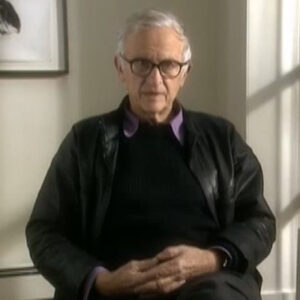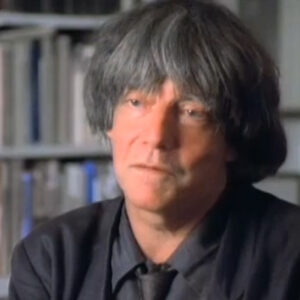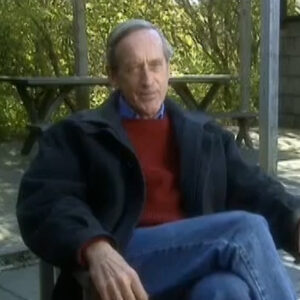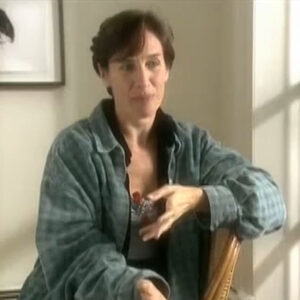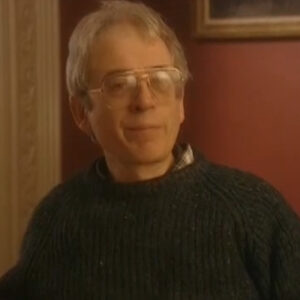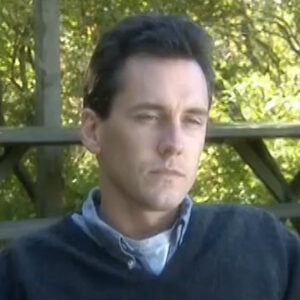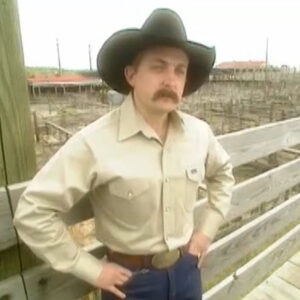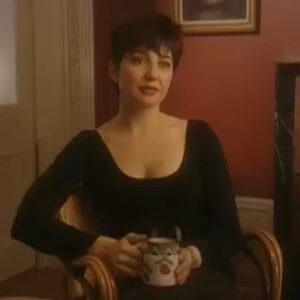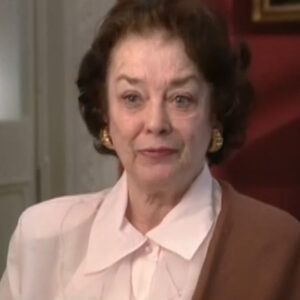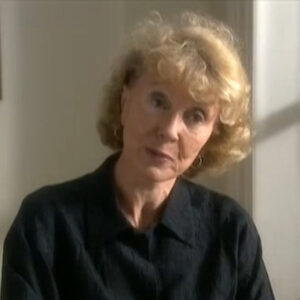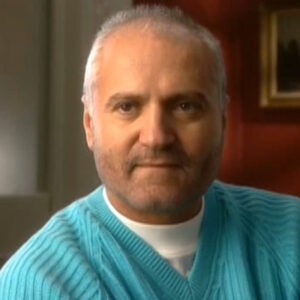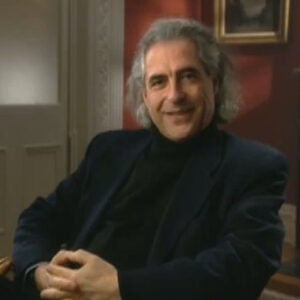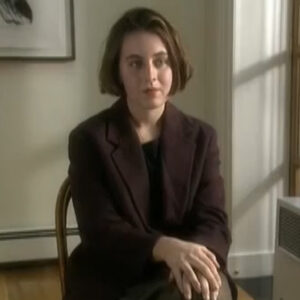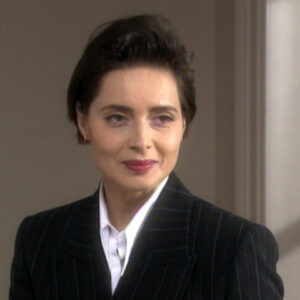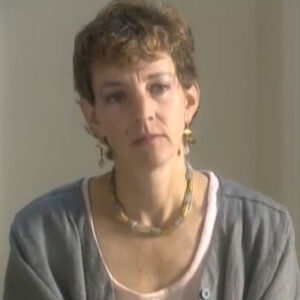Speaker I think what really incites a lot of controversy or elicits a lot of controversy because of his work is just that you sort of don’t get a choice of it like you’re endlessly presented with it. It’s in every museum. It’s in magazines. It’s trumpeted constantly to you about how amazing he is and how great he is. And here’s the latest thing he’s done. And here’s yet another book, and here’s yet another exhibition. Here’s yet another unique, amazing thanks to sort of almost are so taken aback and overwhelmed with with its omni presence that you sort of don’t get a choice. And I think people get a little pissed off because they get robbed of even having having a choice. You know, it’s like you can’t change the channel. He’s the he’s that on every channel and is a piece of that. I think there’s also a piece of it that’s just a lot of jealousy on the particular part about the photographer in the photo community, because here’s a guy who’s clearly don’t had done really well throughout his whole career, and he’s yet he get and he’s clearly very successful, very wealthy, and yet he gets grant after grant. And, you know, of course, all the starving photographers out there, thank God, you know, for what he gets. One of these things that could support a thousand guys like us, you know, that kind of thing. So there’s a lot of just out and out nasty, good old fashioned in your gut envy that goes with that.
Speaker You know, I think there’s a lot of it, too, that comes from a snootiness that sort of well, fashion photographers can’t make art. Fashion photographers can’t be journalists. Fashion photographers aren’t serious. And and commercial photographers and successful photographers can’t be taken seriously as artists, period.
Speaker I think there’s a whole thing that comes out that’s before you even look at his work. That’s what I even like, turning the page or walking through the museum door or picking up a magazine or anything. That’s all. That’s all stuff that comes to bear before you even look at a single image. So that’s like a lot that’s a lot to weigh against this. A kind of a lot of opinion and emotion weighing in before one lays eyes on an image. So that’s that’s a lot. On the other hand, if you hang yourself out there, you’re inviting this stuff and he’s endlessly hanging himself out there. You know, he’s a he’s this kind of very public available person to either love or hate, you know, and because he he’s so visible all the time, his work is so visible.
Speaker I think he’s hanging himself out there and allowing himself to be available for either, you know, acclaim or criticism. And he gets plenty of both. I think that once a lot of the criticisms that you hear about the images themselves range from things like race and things like, well, he’s more a. Kind of almost more graphic artist than a photographer like the you know, the photographs don’t have staying power. They don’t have they don’t you don’t want to linger with them. You don’t they’re not chin strokers.
Speaker Your uncle is your mom like.
Speaker Whereas on a magazine page, it’s like, wow, cheese’s wow. Cut. It’s like kind of one after another that are kind of these like Pam, Pam, Pam, really, really looking at them. And they’re very in your face. They’re filled with tremendous energy. Even the quiet ones are filled with a kind of.
Speaker A kind of energy, I mean, there’s a kind of like potential energy maybe that’s there, but they’re certainly they’re not they’re not waiting for you to kind of peel away the layers of the onion slowly as you, you know, smoke your pipe and kind of stare at the images there. They’re right there. There’s not like layers more to discover, particularly. They’re very available. And I think that’s what makes them really strong. Certainly as as magazine images, it makes them really strong. As you know, as commercial images are published, advertising images as well, is that there are you turn the pages like bang, you’re locked in. You see everything you need to see right away and you get it. It’s as communication. It’s pretty effective. I mean, it’s you know, it’s it’s it’s unambiguous for the most part and unequivocal. It’s right there. It’s immediate. So I think that’s pretty great. As a communicator, as a. As an editorial communicator, he’s right up there. You know, I think the fine art community has has problems with that because they have problems with. They have problems with taking images from one. Venue, the venue of the printed page, and having it appear elsewhere on the walls or museum or in a book. And I think that tends to be OK with them, with the fine art community when they’ve decided to do it, when the guy’s been dead for 20 years or a hundred years. And they say, you know, now that we take out abridges photographs out of out of the context in which they originally made, now that we take another person’s photographs out of the context in which they originally made and we decide that actually these are fine art, then it’s cool because we’re curators, we’re museum director, that’s fine. But for someone else to kind of say, hey, this is you know, I’m telling you, it’s art before we even start out here. That’s that’s kind of taken the decision out of their hands. I think there’s a lot of resentment, resistance to that. And I think that’s just compounded by the fact that. It happens again and again and again. He’s really good at it. He’s really successful at it and he gets a lot of support and acclaim. So I think that really, like, you know, that kind of gets everybody’s goat quite a bit. I think you have to take your hat off to. So a lot of things, I think you really have to take your hat off to the prolific. That’s a word. I mean, here’s somebody who has been beating his head against the, you know, photographic wall for. What, like. 60 years more. I mean, almost fifty five years. It’s a long time. And someone who has continued to although certainly his work can be broken down, down into specific kinds of themes and areas and directions that he’s pursued again and again and again, much as credit. Kind of like re exploring and reinvestigating. Something’s kind of tapped into before, but trying to see it again, trying to see it again, trying to get it right. Really trying to get it right. He just like beating his head against the wall that time. And yeah, he’s successful in the ice, financially successful. And yeah, he’s got all this acclaim, but he’s been this ad against a wall out there. He’s visible. You know, he’s not hiding away in a professorship somewhere where he did as like one mediocre show that got him one place in 1945. And he’s kind of like, you know, got his tenure and he’s hanging out on that for 35, 40 years. Here’s what that looks like out there, cranking it out. So I think there’s a lot of applause for that. This for me, anyway. I think there are a lot of images which have been endlessly copied of his that you see constantly. I mean, I wouldn’t even I wouldn’t even dignify them with words like referencing an appropriation because that’s something else. This is like shameless ripper Ofri. I mean, it’s bad. His image has been ripped off so often. It’s a dreadful thing. So that’s that’s a form of compliment, I guess. But but it’s certainly if it’s not a compliment, it’s certainly. A sort of barometer are very available barometers to his the level of his influence and the level of his level of his influence and level of which he’s impressed. Made a strong impression on so many other photographers. And it’s just this there’s so much work now, even though certainly he has his own influences, people like Mom, Karshi and other people through the years. But you see the work that’s around now in fashion and got it’s been pretty hard pressed to to not Drost parallels to a lot of his work that was going on many years before these photographers were born. So it’s pretty great. You know, and I think another piece of the controversy also probably could put down to kind of this evil twin thing where, you know, people people think, oh, evidence coming to take my picture. That’s I’ll look amazing. It’ll be a beautiful thing. I’ve I’ve seen these very beautiful, nice, nasty Kinsky. These amazing portraits ceased under a very beautiful, very flattering, very lovely. And people are kind of seduced into that. And then the guy that shows up at the door is kind of the evil twin of that guy who actually is the passport photographer, you know, who’s gonna do this kind of very kind of fly trapped in amber. Not necessarily compassionate, not necessarily on your team at all, but very much with his own agenda coming in there and and using you to project his brain on to, you know. And I think that’s another piece of people feel a bit like they’ve been had, you know, and I think that’s too bad for them not to speak so ill of him, though. I think it’s like everyone’s you know, he’s he’s an artist. I think that’s fine. You know, he’s admitted many times that in no way is what he’s showing you a truth or the truth on any level. I mean, he’s said as much very clearly, you know, he’s saying it’s not so much a portrait of the person in front of the camera. It’s very much his agenda. It’s very much about what he gets. It’s it’s this kind of little dance or a little wrestling match, how violent it gets. But ultimately, he’s never not the winner. Ultimately, he’s the one with control. Alternately, he’s the one who who gets the final say, you know, and the person is at best kind of a vehicle for him to say what he needs to say. And there are worse things you can be than a vehicle for him to say. What’s to say? It’s OK, you know. There’s also a lot of other things. There are things like. I remember going in and seeing an exhibit of his when I was in Atlanta was his pictures of the American West. And they were on exhibit at the high museum there, I think. And I remember going through and looking at them. They’re terrific to see. It’s certainly terrific to see him from there’s such a presence, the big prints, they look great. And I couldn’t help but have all these mixed feelings, which right off the bat, as far as I’m concerned, is good. You know, if I don’t walk through them, as long as I’m not endlessly tipping my hat endlessly pissed off that you’re kind of tipping your hat and being pissed off and doing all those things going through the show, it’s good. You know, that’s that’s like a good afternoon metric. But I couldn’t help but think as the little blue haired ladies were sort of showing us through and like, well, I think Mr. Avidan does. He’s very works very simply. And, you know, you start getting this like a hand explanation that he even knows what kind of relationship it bears, how it’s really done.
Speaker But you can’t help but think about, gosh, I wonder if any of these characters showed up for the opening. Would they even be admitted? Like, would they be like they’re safe? Trapped on this bigger than life sized print on the wall. Free to stare out and kind of either snicker at be an all of contemplate.
Speaker Whatever. But God forbid I should actually run into this person in your daily life. I mean, that could be a really scary proposition. So what he allows you to do, which is kind of nice, is. He’s he sort of stares for you. You know, this is somebody you might see at a roadside diner would be afraid to be caught staring at. And he’s happy to stare at him. You know, I think there’s. That has its ups and downs. I think that there are those particular those in the business who kind of know how stuff goes on, cringe at the notion of this guy sort of going about the American West with this fabulous entourage.
Speaker And so I think, oh, he’s wonderful bringing him over. No, the filthy one, you know, with a with a torn shirt. Oh, I love him. Let’s get that one or the one with the funny nose and the the broken teeth. Love her. Bring her over. She’s fabulous.
Speaker That kind of I think people cringe at what that might be. That’s pure, you know, conjecture on my part. But I you know, I can imagine. I don’t know. I feel like, on the other hand, once he’s done that. The gift to me is I can now stare at this person who, as a photographer, maybe I would or wouldn’t have the courage to go up and say hello to. Maybe I wouldn’t photograph. Maybe I think about photographing. But he’s done it. And I take off my hat. You know a lot. Anybody who’s done that, I think that’s great. And he’s kind of even those pictures, on the one hand, seem sort of a bit unfair. You know, like, would he want to be seen that way, really?
Speaker On the other hand. These people might never be noticed at all. And in a sense. Even though he’s manipulating them. A lot, and maybe sometimes cruelly and maybe sometimes.
Speaker I don’t know, it’s like the the argument, I guess, is that a lot of people feel the pictures are uncompassionate.
Speaker And yet.
Speaker I don’t know. I think he loves all these people a lot. You know, he’s paying them a tremendous amount of attention.
Speaker And he’s kind of preserving every little detail with a great deal of love in a way, you know. So I think that when you see the images that comes through, I think at a quick glance it’s like, wow, he’s ugly. Gee, that’s gross. Gee, what a weird guy, you know? That’s like the instant thing. But then if you actually do stick with the pictures for a minute, I don’t know. There’s there’s some kind of compassion there that does come through. And I think the fact that they are shot sort of passport style and stripped of all the other kind of. Accouterments of familiarities or environment or anything else that might be used to distract or enhance the picture. You really just left with a person in all their humanity. And there’s something that’s really. Appealing about that. I think it’s kind of great. And I think he so much owns that kind of picture that it’s as simple as it is.
Speaker You need to figure out other things to do. I mean, like, it’s it’s such a distilled down essential way of saying something that.
Speaker He’s boiled it down to the bare minimum. You know. I think another thing that’s hard is that.
Speaker It’s no longer a time when you can look through and discover a picture of him and go, wow, that’s amazing. Because. You already alerted by fireworks and alarms and sirens and giant banners before you ever get to the photo, like you can open up New York magazine and just flipping through the table of contents, you’ll find out that it’s whoever photographed by Avedon and you’ll flip to the page. And you already you know, you can’t just be flipping through a magazine, say, wow, that’s an amazing picture. Oh, turn it sideways. Oh, God. Avalanche. Amazing. What a surprise. I would have thought it was an amazing thing to sort of already are thinking of it. Which is. Unfortunate, the way you’re already thinking of it is like, oh, it’s when I have announced pictures and you kind of have to look at it in that through that filter. And I think what happens a lot is photographers get to a level where they’re sort of like bullet proof, you know? I mean, they they’re not bulletproof to the extent that people can criticize, but they will endlessly still criticize. I can’t say the criticism won’t affect them, but they’re. They’re bulletproof, like they just keep on. They’re like the Terminator. They just keep on going. You know, it’s like the gunshots are fired. They’re like Swiss cheese, but they keep coming atcha. And I think he’s one of the people that’s reached that level where the criticism can come and go. But it sort of is all interesting and helps fan the flames and basically contributes to the ever increasing fame and stature that he has. You know, the more the more people that thumb their noses, the more people would applaud. It just kind of keeps edging him up one more notch when we’re not one more notch somehow. So I’m. The bad thing about the bulletproof statue is that you can no longer see it fresh, you can no longer see him fresh. The good news about the bullet proof statue is it allows him to keep on cooking, you know, and that’s good. It’s nice. The end of the day, it’s you know, it’s great that he has the pictures out there.
Speaker Thank you for. Last question. Does one have one significance reservation about the just the Blackwater thing, the idea that you could just talk about that?
Speaker Anybody else mentioned that at all? They do it, but not mention the Blackwater. Would they talk about wanting it both ways? Yeah. Just use him. Make sure you support online as a photographer, too. Yeah. Yeah.
Speaker My talking to my shoes too much. I’m sorry.
Speaker Another thing, I guess, that gets talked about a lot with regard to his work.
Speaker Actually is a couple of things I could talk about with this sort of he’s by his very bulletproof ness and fame and stature. His life has become not only a storybook, but like a template that I think other photographers tried to use for their lives and careers in a very self-conscious way that I don’t know happened so much before. Where?
Speaker Something you see around now where photographers already make sure there are pictures of them at their shoots. They can’t they can already kind of see how the intro to their book is going to be peppered with something, you know, being photographed or sounds or sounds that you just kind of think you didn’t really see before. But now he’s kind of like he’s put out the ground rules. He’s showing you how to do it. And all these other people kind of way too early on project forward. And they can it’s like sort of like they’re planning out the retrospectives at twenty five, you know, and they’re kind of as they move through their careers, they’re making sure the stuff kind of set aside and being done I think has the deliberateness.
Speaker The sheer deliberateness of his career kind of. Has had an effect.
Speaker I think something that also elicits a lot of controversy about his work is that evokes a lot of controversy, is that. And again, this is something that you see more and more is.
Speaker And it’s hard to decipher in a way, it’s hard to really decide on. Where photographers who do fashion work. Don’t feel like that’s enough that they need to do something that’s serious. They need to be taken seriously. So they go to Vietnam or these days they go to Bosnia. And sort of by kind of, you know, taking the Concorde and spending four days in Bosnia there, all of a sudden, you know, on the Today Show’s photojournalists, now they’re photojournalists because that now gives them a weight that’s very serious and others not just kind of celebrity photographers or fashion photographers. And I think, again, something you’re seeing now that was happening back in the 60s that he was doing and. That goes both ways, too, if you if somebody has an amazing kind of talent and perceptiveness, you might go in somewhere where other staffers have been slaving for months or years. And in five days, you might just be able to kind of see it with a crystal clarity that’s astonishing and come away with images that are memorable. Other people now do that kind of thing because it’s just a good thing to have have in your ammo belt. It’s a good thing to have under your belt, you know. And I think there’s that sense of fashion photographer. But then they go to a mental institution, fashion photographer, and go visit a war zone fashion photographer. But then they go photographs, some poverty somewhere. Fashion photographer. Then they have portraits of fringe weirdos. You know, this kind of that duality of wanting to have it both ways. It’s like I want to make a million dollars. I want to hang with the beautiful people. I want to photograph all the fascinating celebrities. And as I said a generation earlier, the intelligentsia in all of our time and I want to be a see the pass photojournalist and I want to be taken seriously.
Speaker And and then and, you know, and I think in his case, it’s it’s as if, you know, kind of eight thousand books coming out in the last year, you know, sort of you get the sense that he was finally for for there to be a universal declaration of Medal of Freedom, that just as we the people of America and the world and the cosmos acknowledge in absolute unequivocal, unilateral agreement that you are the best photographer that ever lived and maybe ever will like.
Speaker It’s so important to like have that agreed upon before he kicks the bucket. He’ll like it. It’ll be too late if it’s another hundred years from now. We want it now. Like we all agree, it’s etched in stone. There’s a monument. It’s in Washington. People can go visit it. It’s there, too. You can rest easy. But we’ve all decided you’re the best.
Speaker Know something like. That’s a funny thing. And it’s a funny thing because I feel like it’s even made him reconsider work that he’s done from years ago. And again, you see the work, you know, the old work cropping up in the even the most recent books, you know, kind of theoretically under the light of being re-examined in a new light, that kind of thing. And one thing that that certainly I see as a photographer that maybe is not such a big deal to the general public, but something I’m aware of and it bugs me. It does bug me. Is and it kind of falls into the mix of kind of admiration and, you know, being abhorred at the same time. You know, that I have for him is that. I think we’re you know, for photographers, there’s a little black border that photographers can print around their images and what that is that kind of.
Speaker We have one. That’s OK. Well, that’s OK. OK.
Speaker As a photographer, one of the things I’ve noticed and pay attention to, because it’s something it’s I think it’s serious. I think it’s a serious thing. And it kind of relates the notion of having it both ways. The kind of. Graphic designer, slash, perfectionist, and the kind of seat of the pants slash, photojournalist slash gut level emotional scene, it is it is realism, liver of life, you know, person that I see him as kind of wanting all these things. And as a photographer, there’s a there is a graphic. You can I guess he might see it as a graphic device. It’s when a photographer, black and white in particular, when you print a photograph, you can choose to include the black border around the picture. What that is, is the actually the clear area around then on the negative that surrounds the actual image. And photographers like Cartier-Bresson people before him would insist on having their photographs printed or would print them with that black border with that would tell you tell the viewer sort of like a badge of honor in a way. What it would tell the viewer is that this is a document. This is the fully image, edge to edge, corner to corner that I saw as I saw it at the moment of exposure. I’ve not played with it. I’ve not altered it. I’ve not crop. That is really what it’s saying, because you can certainly burn it in or Dodger to make it lighter or darker, print contrast or flat or do all kinds of other things was certainly a form of commentary and editorial control. But at least on the on level of cropping, which has always been a big issue with photographers, particularly photographers issued for magazines, it’s always been a big thing with cropping the photograph. It’s like who has the final say? And for photographer, that’s also for a photographer was in any way seeing him or herself as a journalist. It’s a really important tool that because what it’s saying is that this is like an eyeball quote. These are the Blackwaters like quotation marks. Everything within this black border exists as if it were inside quotation marks.
Speaker It’s it’s an accurate it’s an accurate representation of what I saw Simon saying. It’s an accurate, accurate representation of what was there, but it’s an accurate representation of what I did at that moment, the moment of exposure. This is the full image. I’ve not played with it. I’m not cropped it. OK, that’s a big deal to me. It’s a big deal that, you know, be like if you’re interviewing someone writing a story and you conducted the interview and it didn’t work out quite as well as you wanted. And rather than just taking it and writing the piece in your own words, which is certainly fine.
Speaker Wanting it both ways. Which is getting on that. What bothers you? I’ll be really fast. Tight. OK.
Speaker OK.
Speaker So as a photographer, there is a sort of a tool that photographers use, which is the blackboard that exists around a photographic image. And it’s it’s the clear area around the actual image on the negative that when printed, shows black. And that’s like having quotation marks. It’s showing that that’s the full area, corner to corner, edge to edge of what was seen at the instant of exposure and letting the viewer know that the picture is not being cropped or supposedly tampered with. So it’s like having a photograph in quotation marks and photographers like Cartier-Bresson made that like kind of almost a hallmark of their work because they took such great pride in the in the accuracy and and uniqueness of their vision, particularly at the moment of exposure, like Cartier-Bresson, the decisive moment.
Speaker That shows you that that was it. And that’s a very precious thing.
Speaker And among photographers, it’s not it’s something that nowadays is often used as really just a graphic device because it sort of looks cool. It sort of looks rough or edgy or, you know, gritty or journalistic or something, you know, kind of looks cool. But it really means much more than that of saying this is the actual object is the actual little document of what was there. I think what’s tricky in in in avalanche cases that that when he has used that particular on his large format photographs where you see the edges printed, the little black edges with the little notches that you see, that’s even more effective in a way, because the sheet of film does exist one at a time. It’s not like cropping, choosing one frame out of a 35 millimeter motor driven roll that’s like banging that bang, bang, bang, bang, boom. This is the one I pick and then putting in the little black, you know, showing the edge of the negative. These are these things that actually are exposed one at a time.
Speaker There weren’t like plate. Like old plate film holders and a one one sheet at a time. So you really seeing it as this object very much being presented as this is an object. There’s a document. It’s an actual thing, you know. What I found out recently, which was very horrifying to me, was that actually using computer technology, which is no big deal, because you could do it before without computer technology. Was that what he was doing is kind of isolating the black border in a sense as a design element? And then recrossing old photographs and shrinking, enlarging them within the blackboard and then putting the little border back on as if to say, well, actually this was the. This is actually what it was. This is the document. You know, and that’s kind of horrible because it’s like an interview. We were doing an interview, a reporter getting the quotes, writing the story in the quotes, not really being juicy enough or not being quite how you’d hoped they’d work out. And rather than either writing the story in your own words, which is fine, or using the quotes as they were to the best effect you can. Which is fine. It’s actually writing the story in your own words. And then just putting the quotes back in. And that’s not OK. That’s not journalism. That’s not a document. That’s not anything. That’s what that is. That’s lying a lot. And in the worst possible way. And and sort of nobody can knows that that’s going on. And what’s said is certainly what’s implied, even if nothing said is that this is a document and it’s not. And that’s a technique that’s done a lot in the advertising work. I mean, I brought it up to someone who knows his work really well and says, oh, goodness, you know, with the Sloshy Kinsky, there’s the one of, you know, her and the serpent. And she was from frame 12 and the serpent was four, frame 17. And that on it’s like, oh, I didn’t know that. And that’s that’s getting funny to me, and I’ve certainly worked on computers and done a lot of work that way, and that’s fine. It’s the notion that this is being presented. It’s like, wow, he actually got this as it is. I mean, there’s something really distressing about that.
Speaker Certainly less so with the Nastasi Kinsky kind of picture, because that’s just like a very beautiful photograph. And that’s fine. And certainly in the fashion advertising work, as you sort of assume that there’s a lot of retouching and stuff that goes on, although even there.
Speaker And that’s a huge can of worms is particularly women. Photograph of fashion and advertising work, retouched to death in their images, get put on the cover of magazines. And women all over the world wonder why they’re made of different flesh than this person they see on the magazine. How come she looks so great? I don’t look that great. She must be made a better stuff than me, you know. And then you get the passport photos. Which if they are retouched, aren’t we touch from a vanity standpoint? They’re retouched. Well, the egos are different when the ego is not theirs anymore. It’s his. It’s like he’s not retouching for their vanity. He’s retouching for his vanity. And he’s not like, you know, about it. And that’s a funny thing.
Speaker You know, they’d be more interesting as objects to see them. Screwed up in whatever way they screwed up with, like tape marks and X’s on him and overlays and scissoring or, you know what I mean, or to see the big man with all the extra BS tape down that we’re put in. I’d rather see that. That would tell me more about it. But there’s something that a lot of photographers show, which is sort of this anal kind of quality of wanting everything to be just so. No matter what. And it’s kind of like for all his traveling and for all his exposure, other people for all that he’s seen and done. It’s like he refuses to let life. He refuses to accept, it’s like it has to be he has to have the last say. He can’t just take the lesson of like, well, I was hoping to be photographed and work out this way. And actually in photography, there’s always a parallax error. Like, you’re aiming for the picture over here and the picture ends up 30 degrees to the right. It can’t ever not be that way. A lot of people.
Speaker Ah, very kind of cater to a very flattering when they’re photographing people of power, white folks. People who have money and people that have influence and prestige in one way or another, where they really tend to get all serious and journalistic and just about, you know, bust an aneurysm. Being serious and unflinching and uncompromising is when they’re photographing people who are powerless, black people, other minorities, poor people, people in hospitals, people in asylums, people in jails, because then it’s easy. These people are powerless. They’re not going to do anything to you. You’ve got the upper hand. What’s kind of nice about what he does, even though it’s not flattering or anything? What’s kind of nice is he’s equally nasty, if you want to look at it that way to everybody. He’s just as happy to take. A direct human, unflattering, uncompromising in his mind, photograph of a coal miner as he is of an asylum patient, as he is of Henry Kissinger, as he is of someone else. I applaud that. There’s not too many people that are that brave to be willing to risk disapproval by the wealthy and powerful. On the other hand. He’s he got he got to bulletproof them when he started doing that. I mean, like, sort of he was already almost in the bulletproof realm when that started happening. And that helps began to take off your hat to that. That’s like moat. Many photographers only get serious as a heart attack when they’re dealing with people who are less powerful than their, you know, and he’s he’s dealing with it both ways. And I think that that’s a good thing. It’s an interesting thing. And I think a lot of envy comes from other photographers because they know that they don’t do that.
Speaker Let’s just try to do this really difficult. So me which, by the way, take a lot of what you said and talk about the nature of the controversy. So I cited examples and decided the serious on site.
Speaker And if elected.
Speaker I think a lot of people are particularly photographers, other photographers, other artists are really bent out of shape.
Speaker And he he definitely his work evokes a lot of a lot of controversy, a lot of mixed feelings for a lot of reasons on a lot of levels. I think the biggest one is that he’s just in your face all the time. You don’t get a choice. Like every time you turn a page. His work is there. He’s kind of come endlessly trumpeted as like the photographer of the universe. He’s in every, you know, major museum. He has 15 retrospectives going on at once as works on tour. He has forty seven books that just came out in the last three years. He’s the only photographer ever hired by New York magazine to ship. It is like endlessly, endlessly, endlessly. You don’t get a breather. I think people get robbed of their opportunity to love him or hate him. And since they’re kind of robbed, they say, well, I’m an item. You know, I think the end becomes because he gets all this grant money and people like, well, jeez, he doesn’t need it. He’s rich. Anyway, we just need to take rich grant monies for poor starving photographers, for real artists, not for commercial guys like him. You know, there’s a lot of that. I think there’s a lot of envy because he he likes to have it both ways. He’s somebody who wants to run with a fast crowd and wants to be with the fashion elite at the same time, wants to be considered like a serious, you know, documentarian. You know, a photographer out there going for the grit, you know, and I think and as beautiful as his beautiful work is, that’s how gritty and unflinching and ugly the personal work can be. And I think that that’s almost so much in like boldface type in italics both ways that it’s like a writer, Eddie. It’s too like there’s no subtlety to it. I think another level of the criticism comes from the fact that people sometimes see him as more a. Like a graphic artist, not a trickster, but like somebody who employs the techniques of the graphic arts and that that makes the photographs. Perhaps not as lasting or perhaps too superficial. You know, they’re great for the quick like one two punch in a magazine or like you walk into a museum to see this, you know, 50 foot photograph in front of you. It’s like, wham, it’s it’s there. It makes a big impression. But does it have more levels? Does it have more subtlety? Is it you know, is there is there are there any levels to the onion other than the top skin? Is there anything more going on? And he said himself that often, you know, he was really looking for a surface. But just because he says it does. That’s just it’s an easy out. In a way, it’s just like, you know, diffuse the whole criticism by kind of repeating it in a way.
Speaker But I think that’s a big piece of it. And I think. I have to ask you, am I? I’ve lost my famous. Do I want to go to the Blackwater from that or Dakota Senate race or the nature of the criticism?
Speaker Well, I’d love you do again, a pithy way, but personal and problem nine is what you feel has been your singular contribution, portraiture to fashion. How he’s made people think about the dog in a different way. But coming from you as a photographer, you have really tight.
Speaker I guess I feel his influence and I feel. I feel sort of washed over by the tsunami of evidence presence.
Speaker You know, this kind of it’s not like can go for a dip when you feel like experiencing the work. It’s like you go to the museum and there’s this tidal wave that blows, you know, bowls you over. I think what what you’re left with, though, at the end of the day is somebody who’s really just so incredibly prolific. So incredibly.
Speaker Passionate about needing to.
Speaker Needing to see faces, needing to see human humans in the most.
Speaker Direct. And.
Speaker Direct and telling way like like a face cartographer. You know, it’s like he’s making these face maps for you to see in a way that’s not like Chuck Close.
Speaker In a way that’s actually making these people.
Speaker In a way that would seem cruel or uncompassionate because of the starkness and the coldness of the presentation. But if you just go for one more level, there’s actually this tremendous compassion and really this love of all these different characters. I don’t feel thing of like, oh, he’s really ugly.
Speaker Look at her. Oh, my God. Can you believe should when I love the combination of pants and shirt he’s wearing. It’s fabulous. You’d never see that. I don’t think it’s that.
Speaker I think, oh, I love her just the way she is. Jesus, I love this. Look at this guy. Oh, man. I just want to I want to be able to drink him in from the top of his head to his toes. I want to be able to just stare at him forever. I think that’s pretty great. And I think that also he’s taken it socially. He’s taken it up and down and sideways. He doesn’t do what many photographers do and that they they kind of are very reverent to those in power and are very sort of unflinching and uncompromising to when they are photographing the powerless to those who are economically or for other reasons, the powerless people in prisons, hospitals, asylums, war torn countries, that kind of thing that you see a lot, but also the unflinching the stops when they’re photographing people in power, often they’re very reverent. They’re very much catering to the vanity of those people. And I think that’s a big difference with him. I think he’s a he’s truly egalitarian that way. I think he’s.
Speaker He’s as equal to apply that vision whenever whenever he feels he wants to, whether he feels it needs to be. And I think in fashion work just the stylishness and the energy and the freshness. And again, that the productivity just being out there, like again and again and again and again and again and again and again, just cranking it out. I think that just the level of energy, like you just have to take off your hat and applause applaud.
Speaker You know, just it’s there. One more thing. You spoke earlier again about the signature that you thought was so compelling for these men about the white background putting that person. They were all the thing they love itself and how that really his big piece, he’s made it his own.
Speaker Right. OK, that’s a that’s a contribution. Right. And if again and again and the evidence comes contribution or for his signature, what he’s given to us, given the photography like.
Speaker I guess I’d feel also that a real’s kind of signature of is a real, real, um, really important contribution is that.
Speaker He’s sort of taken these early influences of not consciously necessarily taking these early influences of passport photographer and Broda vich inspired graphic designer, you know, and kind of married the two things into it.
Speaker And they’ve.
Speaker He sort of synthesized them and spat out a new kind of photograph, which is this kind of incredibly stylized, incredibly heightened realism of this stark portrait on a white background with no distracting details. That’s very in your face. It’s very confrontation. Even when the person that looking at you, it’s confrontational. It’s graphic. Yes. It can be very loving. It can be very affectionate. But it’s not. The starkness of the photograph leaves the love.
Speaker Just just to the subject. It leaves all the emotion just in the subject. And that’s it. And that’s that’s it’s something he really owns. Now, it’s such a simple thing to own, but it’s something that any photograph that shot that was clearly just like an inferior repetition of what he’s already done better. And it’s such a simple thing to own. But you really can’t shoot that picture now. It’s really not a picture you even want to shoot. It’s a picture that he’s just he’s got it.
Speaker You know, when most things we talk so much a day would take about a human face. And I really love what you were saying, if you could bring that perhaps into the contribution that he’s a cartographer.
Speaker All right. Just perhaps no one else brings that kind of love, the human face in what is a cartographer, what you see through just. I love that idea. You bring that into the contribution.
Speaker Evidence talked a lot about how how he doesn’t feel the need to go beneath the surface, that he feels like the surface is it? The surface is everything. Like that’s that’s what he wants. What what you’re taking a picture of, in any event, is the surface. It’s not the soul that it is the surface. That’s what you’re reading. And on that level, I think he’s he’s like this amazing cartography is like the map, the face mapmaker. You know, he’s somebody who feels that.
Speaker It’s somehow like if you if you chart it all carefully enough, you can know the whole you know, it’s like if you if you drawn every little valley and peak in river and street and, you know, it’s miss that you can put in there, then that lets you know better.
Speaker What you’re looking at, and it’s kind of what this incredible love and affection for the subject that he pays, it’s such careful attention, such really, really careful attention to detail, like careful attention to gesture, careful attention to position within a frame. Careful attention to not having anything be there that shouldn’t be there. Careful attention to just eyelashes and spil running down the chin. Careful attention to everything. Because not because he’s snide, which I think is a big off off.
Speaker Her criticism of him because he really loves it, because that’s.
Speaker He really loves humanity that much and he wants to. He wants to see it all and he knows he can. You know, there’s no there’s no shrinking from the lands. He knows. He wants to. He wants to and wants to get it all in there.
Speaker Thank you to the cartographic. OK. Actually, something is revealed.
Speaker Why don’t think if something is revealed. I think.
Speaker I think at the same time that he’s being a cartographer and wanting so much to see what’s there before his lands. And he’s insisting that nothing’s revealed of the person, that all you’re doing is showing what’s on the surface, that clearly you can read things into the surface. Clearly, you read things into the surface of his pictures of famous people because you know who you’re looking at. But you also the fact these photographs, so many people that aren’t famous, so many people that are, in fact, nobody’s. And you read a lot into those. Kind of gives these people the dignity that they deserve and allows you to see more into them. I think ultimately what you see more into, though, is inside his head. It’s like it’s like reverse photography. It’s like the light’s coming out of his brain through his eyeballs and he’s shiny around the people. And what he’s photographing is like it’s all. It’s never not a self-portrait. And what you’re seeing with ever increasing crystal clarity. Is is that you’re just seeing him more and more and more.
Speaker One actually, one last thing with the gun. So it’s really concise at this point about things that I really to.
Speaker If you would summarize the criticism in the West when it came out, it caused a lot of heat some way. Yeah. Just very briefly, what were the main. What a lot of people what what about that particular body of work which we’re going to be showing the.
Speaker I think there were two things about the American West that really got people bent out of shape. I think one was just the fact that he got gone, haven’t gotten this huge grant to travel for a long time around the country with his assistance, with the whole kind of entourage to do this body of work. It’s like even if it is a terrific body of work, it’s like, well, model tough. It ought to be. You know, it’s like I could hit you could hear even if you couldn’t hear him, you could hear for all the time saying you if I don’t. God, if I got, like, you know, mobile home and film and assistance and helpers and researchers and all I had to do stand and go.
Speaker He looks fabulous. I love her. Get the fat one. I love the one with the awards. Let’s get this one.
Speaker You know, that’s how tough is. It’s like shooting fish in a barrel with a shotgun. You know, I think there’s a lot of that. And I think a lot of a lot of it also was this incredible sense of outrage that here was the sort of. New York elitist fashionista going around the country, taking a microscope to all the warts and a microscope that he was keenly aware of and that they weren’t, that it was a really unfair kind of a thing, that he’s kind of going around the country picking out all these fabulous misfits and putting them under his microscope and then pinning them up on them on the walls of the museum for us to see. And I think people really hated that. They really resented it. You know, and. That goes both ways. You know, there’s I think that’s what it was. That’s what it was about. And I think that photographs can be. Misleading they can. They’re supposed to these are being supposedly present as documents, but they can be misleading. I mean, you can take a photograph of a guy wearing plaid pants and a different kind of plaid shirt and a different kind of this and that. And all of it doesn’t fit. And he’s kind of unshaven and looks weird. And you take a picture of him in an off moment. He just looks all kind of messed up, you know, and awkward and snazzy and weird. And actually maybe he’s somebody has a terrific sense of humor, is a fancy dancer, and there’s been marvelous to his children. But you don’t get that. What you get is this image. And that’s what’s always key to remember is that it’s a picture of Dick. It’s not a picture of this guy. It’s like all these people are standards for his ever evolving self-portrait. You know, I mean, it’s like. I think that’s what for me diffuses that whole. Sense of outrage is that as soon as I get that it’s not them, I’m looking up at him. Then it’s fine for me, then it becomes much more interesting.


